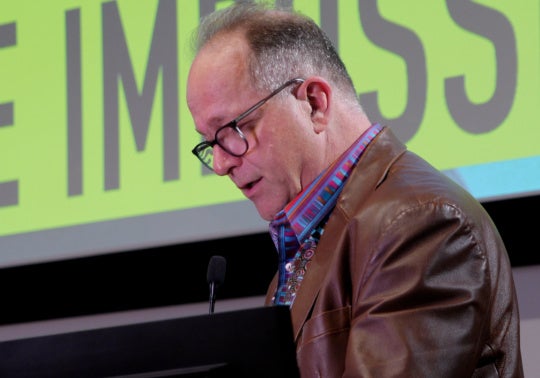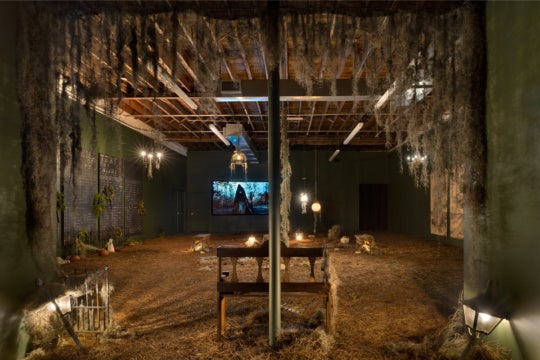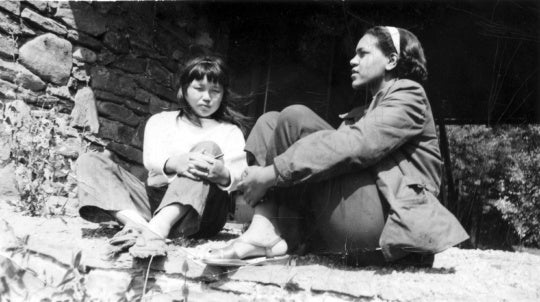Idea Capital recently announced the recipients of its 2013 grants, and the group of artists represents the diversity of communities, interests, and media in Atlanta. I talked to two artists, Sheila Pree Bright and Helen Hale, and one collaborative team, Marcia Vaitsman and Seana Reilly, about the projects the Idea Capital grants help to fund. In their variety these women capture an essence: that epistemology is the result of intertwining narratives.
Atlanta-based photographer Sheila Pree Bright is known for her series of portraits and images that capture the changing, diversifying faces of modern America. In the new project shes developing, 1960 Who?, Bright reflects on the American epistemic shift that was initiated by the Civil Rights movement. By reminding viewers that it was ordinary people that joined together to create exceptional change, she keeps her camera squarely aimed at contemporary social struggles.
Using her bodys movements as a magnifying glass, choreographer and dancer Helen Hale will demonstrate the symbiotic forces of psychology and soma that give humans the ability to orient and reorient themselves through unceasing environ-mental changes. Having danced from pre-school through high school, and subsequently completed my graduate work in the area of religion and early 20th century ballet, I was naturally curious about Hales choreographic interpretation of everyday rituals in Sanity Ceremonies. Her description of the observances that ease us from one cognitive state to another, such as brewing coffee or tea each morning, reminds us that they are essentially kinetic. In this interpretation, it is impossible to compartmentalize body and mind.
Marcia Vaitsman and Seana Reilly are working together to create a large-scale installation, Heisenberg Boulevard. In many ways, this project will address similar themes that Vaitsman and Reilly explore in their solo work: as a duo, the themes of (im)materiality, foreign psychologies and landscapes, and arbitrary boundaries are even more prominent. There is a way of approaching scientific thought that is more intuition-based, they say, which speaks to a different kind of intelligence… an intuitive way of living in alignment with what naturally happens in the physical and societal domains. Together, they speak to the confluence of energies that is required in acts of creation, and to the production of knowledge that is the result of play, chance, discovery.
Sheila Pree Bright, 1960 Who?
Sarah Levine: Your grant from idea Capital is going toward a new portrait series 1960 Who?, which is inspired by the Freedom Riders. The title suggests that the project hopes to answer a question. What is that question?
Sheila Pree Bright: The project will be a collection of photographic portraits about ordinary and grassroots people who placed their lives on the line during the civil rights movement. They were the youth of the 1960s who were cooks, wives, husbands, laborers, and students who believed whole heartily in a cause for social injustice; they were the nameless who the world has seen in history books, waving signs, being hosed down and beaten by police and national guards. 1960 Who will look into these soldiers roles in the Civil Rights Movement and ask them what it means to be American, both now and then.
SL: Who will be featured in the portraits? Why them?
SPB: Im using the youth of the civil rights movement as the source that was fighting for human rights. I expect this body of work to expose the motivations and ultimately the hearts of youth from the sixties from the civil rights movement, but also the present day youth, who use their voices for social change around the world.
SL: How do you see this project fitting into your larger body of work? 1960 Who? seems like a natural step after Young Americans, but I’m also fascinated by the retrospective shift you’ve taken by looking to a specific moment in U.S. history in order to suggest a direction for the global future.
SPB: I’m looking at the sixties because it was a time where the old secure framework was not going to work anymore and change was imminentcivil rights for African Americans, youth culture, new feminism, counter culture, and anti-war culture. The youth cultures of the 60s demanded revolutionary change by protest and rebellion, and I see these same attributes being played out by todays youthcivil disobedience has become a global model for change for present-day youth.
SL: Your work is shown all over the country, so what keeps you in Atlanta?
SPB: I’m an Army brat and I’m fascinated with the history of Atlanta, the birth place of my parents…my evolution in the South has not come to a end yet, but eventually I will head West.
Helen Hale, Sanity Ceremonies
Sarah Levine: Based only on anecdotal evidence, Ive found that many people consider dance to be one of the more inaccessible arts, especially in comparison to visual art, music and even theater. Have you had similar experiences? Movement is one of the most primal forms of human communication and expression, but I sense that the general public is often uncomfortable with dance as an art form.
Helen Hale: I have had a similar experience and I think it is due to a number of different things, some of which have to do with the form and some of which have to do with our culture and time.
The very fact that movement is a primal form of expression is one of the reasons that the public is made uncomfortable by it. Western society does not laud primal instincts and urges. We live in a society that at least on the surface makes attempts to be civilized in a mode rooted in Puritan tradition that encourages us to button the top button, maintain our personal space bubbles, and not make spectacles of ourselves. Thus, I think we have in some way been taught as a society to view that which is primal as that which is other than ourselves. What is other is often perceived as both uncomfortable and inaccessible.
In a similar vein we often perceive our bodies as other than ourselvesin dance we have to reckon with the body, which is charged in all kinds of ways. It is inherently powerful, intelligent, personal, sexual, political, symbolic, and, therefore incredible. But human beings can be very uncomfortable with all of this.
Dance can be uncomfortable because art can be uncomfortable. All art. Art often pushes boundaries and intentionally shakes things up. In danceespecially contemporary danceyoure taking the foundational discomfort of Art, and combining it with the charged nature of the bodya body that might be used to push a boundary or shake something upand presenting it to an audience who is commonly expected to watch it in its entirety even though they dont really know whats coming. Anything could happen! These encounters present a lot of risk and require significant trust from the audience. Not everybody is up for this.
Also, in todays culture, we are training ourselves to view things in quick bursts. Theres a sense that if it doesnt hit you in the first 20 seconds then its not designed to make an impact. Dance asks you to experience something in time, to wade in the water for a while as a piece unfolds and builds. One of my concerns is that we are conditioning ourselves to equate slow with boring, and consider work that is not frenetic to be inaccessible in a brand new way.
SL: The history of dance has a few larger than life characters whose popularity catapulted them to stardom: Isadora Duncan, Mikhail Baryshnikov, Alvin Ailey, and Fred Astaire are just a few in the Western canon. At the same time, of course, there are hundreds of dancers whose influence is less well recognized. Are there any choreographers or performers whose work has especially inspired your own?
HH: The Akram Khan Company, Ronald K. Brown/Evidence, and Urban Bush Women are companies that I went to see and was hit by a huge inner YES in response to their work. Kun-Yang Lin and Merián Soto are enormous influences in my approach to dance and performance.
I am also very inspired by a community of physical theater and dance makers I encountered in Philadelphia, many of whom work in concert with one anotherHeadlong Dance Theater, Nicole Canuso Dance Company, and Team Sunshine Corporation. Each of those groups produces distinct work that I find consistently on point in its presentation and creative genius. I encounter them as deeply compelling and refreshing for their real-ness, and what they reveal to me about people and about the world.
I will be forever influenced in my dance making by the work of Moving in the Spirit and Lelavision. Their founders, Dana Lupton and Leah Mann, introduced me to dance as a tiny child, and I am still inspired by the work they do in the studio and in the community.
SL: Idea Capital has awarded you a grant that goes toward your creation of a performance that examines everyday human rituals. What’s the impetus and inspiration? Is the piece interested in placing a value-judgment on those rituals?
HH: Yes, Idea Capital has very generously granted me support for my project, Sanity Ceremonies, an autobiographical foray into being both off-kilter and in-stride using a tea ceremony as its initial point of reference. The piece springs from my own questions: Where do I come from? How do I orient myself? Of what metal am I made? What are my modes of navigating the chaotic and absurd? The tea ceremony aspect stems from my rote morning ceremony of making tea or coffee to help align my psyche in the liminal space after sleep.
I tend to find that the more personal a work is the more easily it can be translated into a personal experience for the viewer. So, rather than doing broad research on human ritual, I am examining my own personal rituals and those of the people and cultures of my ancestry. I am fascinated by ritual and ceremony because I find it interesting to think about why we do the things we do. My observation is that people, sometimes consciously and often unconsciously, perform ceremonies all the time; we develop and enact very specific ways of relating to our belongings, spaces, bodies, and daily tasks. At its core, Sanity Ceremonies is about how people navigate life, using my life and myself as the primary territory of research.
No, the piece is not interested in placing a value-judgment on these rituals. I am more interested in showing and sharing what is, and what could be, as a way of opening a door into a realm of thought or experience. I would like to leave an audience with questions that invite them to ponder how they feel about something rather than to leave them with what I feel about it. The work, while made in very close collaboration with my creative team (costume designer Amanda Baumgardner, and filmmaker, Mike Boutté) will be performed solely by me. Thus, I am pushing myself to share in pretty real ways about my own life. So far, building the piece is requiring a lot of self-compassion, gentleness, and humor and less judgment of any sort!
Marcia Vaitsman & Seana Reilly, Heisenberg Boulevard
Sarah Levine: In your individual work, you both are comfortable with using interdisciplinary ideas with a variety of media. Why collaborate for this new piece, Heisenberg Boulevard? What made you want to work with each other? What does creative partnership bring to the process?
Marcia Vaitsman & Seana Reilly: We have helped each other for a while now, loaning help for this or that. A year ago we came together to develop two project proposals, and we felt that there was a moment in our conversations that the thoughts merged, when one was about to say something and the other was already answering. This probably happens because we have been sharing a massive amount of information, talking a lot about our own studio works in very deep and frank ways, and we traveled together to Brazil and Miami last year. We are both researchers by nature: curious, critical, and analytical.
We wanted to go beyond the idea of collaboration as “I make the video and you make the installationfor now we have roles defined that are technical rolesand guess what, these roles started to shift, too. The concept and the vision have been developed together in long loose talks with no specific aimand of course we document everything. Seana is still more the brain and hands for the material world, when math meets physics, and Marcia is more the time and wave brain, how things are timed, how they pulse.
SL: The scope of the installationboth in terms of its size and its theoretical underpinningsseems substantial. Can you tell me about the materials youll use to realize the vision?
MV & SR: The main materials are immaterial: light and sound. The installation in the space will bring some surprises because we will probably use 4 video channels and many audio channels. One of the great things about the Idea Capital grants is that they capture the projects in very early phases, giving the artists the possibility to experiment. That is where we are now, beginning to play with the space that will host the audiovisual channels, we are about to start to build the real models. One thing for sure is that we want to give the public the opportunity to sit down and relax while engaging with the installation. We want people to stay as long as they want, so we are studying possibilities of having inflatable cushions or similar comfortable seating. It is very important to be able to “feel” such works with your body too.
SL: That’s interestingthe ‘feeling’ bit, because what I find most engaging about the project’s proposal is the gesture you make towards the anti-romantic tone you’ll be taking: you describe the installation as one that will untether viewers from a nostalgic, fearful, and romantic conception of Earths natural processes; that definitely speaks to the research-driven and analytical portion of your identities. At the same time, you’re engaged in this intense, collaborative, and creative experience with each other, with your materials, and eventually, with viewers. In school, I was always a little baffled by what I thought was the odd coupling in the College of Arts and Sciences. What’s the relationship between the two in your minds?
MV & SR: There is a way to make scientific thought very approachable through the arts. It taps into a place that is more than analyticalit is integrative, not extrapolative. We both consider ourselves to be researchers, but to talk about the research in a visual way requires something other than equations, charts, and diagrams. There is a way of approaching scientific thought that is more intuition-based, which speaks to a different kind of intelligencean intuitive way of living in alignment with what naturally happens in the physical and societal domains, without having to wrap your head around abstract symbol systems.
There is a normal confusion between science (acquiring knowledge) and modern science. Modern science is not much older than a couple hundred years. It is a slow way to acquire knowledge because the methods to establish the truth (or even only certainty) are very complicated and in most of the times very bureaucratic. It is still the only way today to validate academic research outcomes and their practical applications. However, we have obviously been human beings for many thousands of years before modern science existed. The complexity of knowledge that allowed us to become intelligent beings derives from different ways to perceive the universe, even the mystical and intuitive experiences have shaped us. We could navigate before we had a telescope. Chinese medicine and Ayurveda, for instance, are extremely elaborated cure/health systems and yet modern science is still struggling to analyze how they work. Many of these systems include the idea of learning through the body, which is still an experience-based knowledge. If you look at the roots of the word intuition you will find that it means: to consider, to look at. One could even say that intuition is the very first motivation towards science.
There is a lot of intuition in this project because there is a lot of risk: when we do not know exactly the path, when we have not done it before, we research and follow some mental connections telling where to go. When art meets science (also religions and ancient knowledge) things make more sense, even if you cannot prove it scientifically. We have the freedom as artists to work in this hybrid arena. We both think that art is a mental process as well as science is a mental processeach one with its modus operandi.




